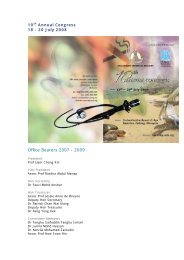download - Malaysian Thoracic Society
download - Malaysian Thoracic Society
download - Malaysian Thoracic Society
You also want an ePaper? Increase the reach of your titles
YUMPU automatically turns print PDFs into web optimized ePapers that Google loves.
Annual Congress of <strong>Malaysian</strong> <strong>Thoracic</strong> <strong>Society</strong><br />
Symposium 3C<br />
Pneumonia<br />
Management of Complicated Pneumonias<br />
Anna Nathan<br />
University Malaya Medical Centre, Kuala Lumpur, Malaysia<br />
Complication with paediatric pneumonia can be due to problems with a) Air b) Fluid c) Lung Parenchyma d) Blood<br />
Problems with abnormal air collections e.g. pneumatocoele and bronchopleural fistula (BPF) are seen with<br />
Staph aureus, especially Panton –Valentine leukocidin or PVL producing strains, Stretococcus pneumoniae<br />
and Klebsiella species that can cause a necrotizing pneumonia. A recent review has noted that there has<br />
been an increased incidence of BPF and this is probably related to an increase in S.pneumoniae serotype 3<br />
(not covered by PCV 7 but covered by PCV 13).<br />
Management of this problem is usually to “sit and wait, however, some may require surgical intervention<br />
especially if BPF is present longer than 14 days. Children with necrotizing pneumonias usually require<br />
prolonged hospitalization. Fortunately, most recover completely.<br />
Problems with abnormal fluid collection e.g. lung abcess or complicated empyema.<br />
Lung abcesses are usually seen in the scenario of a child with recurrent aspiration e.g. cerebral palsy.<br />
As such the organism implicated is usually anaerobic organisms e.g. S. viridians. It may present as single or<br />
multiple abcesses..<br />
Management of lung abcesses is also not to intervene e.g. chest tube insertion, unless there is mediastinal<br />
shift whereby needle aspiration can be done. Chest radiograph changes take time to resolve, usually months<br />
rather than weeks. It is important in a case of persistent CXR findings to think of a possibility of a congenital<br />
malformation of the lung e.g. congenital cystic adenomatoid malformation of the lung, which will then<br />
require surgical resection to reduce risk of recurrent lung infections and the small possibility of malignant<br />
transformation.<br />
Complicated empyema is defined as para- pneumonic effusion associated with persistent fever and loculated<br />
effusion despite chest tube insertion and drainage. Biochemical indicators of a complicated empyemas are<br />
pH < 7.2 , Low glucose < 40mg/dl and a high pleural/serum LDH > 0.6.<br />
Ultrasound of the chest which may demonstrate loculations in pleural fluid are also indicators of a complicated<br />
empyema.<br />
Management of complicated empyema, besides use of appropriate antibiotics is either a) Use of fibrinolytics<br />
e.g. urokinase b) Video-assisted thoroscopic decortications or open surgical decortication. Urokinase is<br />
contraindicated in the presence of a necrotizing pneumonia.<br />
Problems with persistent atelactasis may be due to mucus plugs, foreign body or airway compression e.g.<br />
lymph nodes in TB or malignant disease<br />
Management of persistent CXR’s changes, with no improvement, for longer than 4-6 weeks will require further<br />
investigations e.g. CT thorax and bronchoscopy to look for airway problems and help with removal of mucus plugs.<br />
Problem with haemolytic uremic syndrome ( HUS) is also seen in severe Strep.pneumoniae infections that<br />
produce neuraminidase that cause microangiopathic haemolysis, thrombocytopenia and acute renal failure.<br />
30








